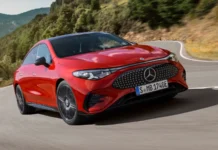For hundreds of thousands of people who have bought a Tesla over the past few years, the prospect of zero-emissions driving and all the technology onboard have been a clear benefit over buying a gasoline-powered car. Even nearly a decade after the Model S launched, however, range is still a chief concern. When you buy into the EV ethos, calculating exactly how much energy you’ll use on a long-distance trip is usually at the forefront of your mind. That’s especially true when you know you’re going somewhere without access to a DC fast charging station.

So, what can be done? What if you want to go camping with your Tesla Model X (or even a more extreme range example, a Smart ForTwo Electric Drive), and you know you won’t have access to a charging station? In this video, we take our gas-powered “Super Tremor” Ford F-250 for a little camping trip to test out the pop-up camper we had installed. As part of that process, we also brought along our Honda EU7000is generator — a massive 7,000-watt inverter that can provide electricity at 120 or 240 volts.
Naturally, it can provide all the power you’d need on a camping trip in the back of your overlanding rig. However, can it actually provide the juice necessary to charge up your friend’s electric car they brought on the trip?
Yes, we’ve been down this road before
If you recall, last year we tried charging up our Tesla Model X with a Generac generator. That experiment wasn’t exactly successful, as it’s a mess less powerful unit. We also had serious reliability issues with the generator running for longer periods of time, and its ability to provide clean and consistent power to actually charge the Tesla’s battery at all. Mind you, even if it was able to actually charge the car, it’s only rated for 120 volts. Even with the Smart ForTwo, you’d be in for a long wait at that level.
Now, the $5,000 Honda generator is much more effective. It’s rated for 5,500 watts, while its maximum power delivery is rated at 7,000 watts. Is it actually able to consistently charge both the Tesla and the Smart, though?
Unlike the first experiment, we were actually able to get it to work! As for how effective it is, you’ll have to check out the video above to find out. All right, it’s still not a hugely practical solution, but it will work in a pinch and the generator is also capable to charge up your home (including an EV, if you have it plugged in) if you lose power. That’s a much more effective use case for spending $5,000, and the Honda generator offers a great amount of versatility for the money.























